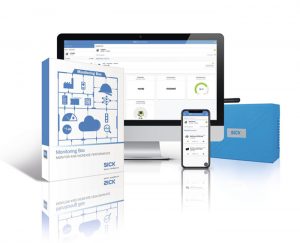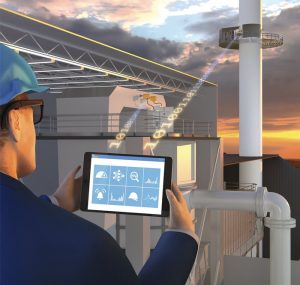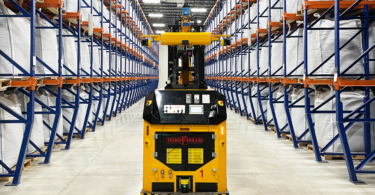Smart Data Solutions from SICK have strengths in a wide range of industries
Electricity, water, and heat are such a part of our everyday lives that we only notice them when they are gone. Energy suppliers ensure that we have a consistently high quality of life with these utilities. Through thermal waste utilization, many modern waste incineration plants generate electricity and heat with low CO2 emissions when prevention and recycling of waste are no longer enough. For this process, gas analyzers are used to aid in environmentally friendly energy production.
The pollutants produced during combustion are filtered out with a complex gas cleaning system. An energy supplier active throughout Europe monitors its emissions with gas analyzers from SICK in order to safely comply with the official requirements for emission control. With “extractive measurement technology,” a partial gas stream is taken from the exhaust gas and fed into the analyzer, which measures substances such as nitrogen oxides, carbon monoxide and mercury with precision down to microgram concentrations per cubic meter.
The aim is to minimize downtime, because legislators in different countries impose strict emission requirements before approving a plant. For example, if the emission measurement system fails, the operator is threatened with large fines, or officials could even shut down the plant. This makes high availability of analysis equipment even more important.
Regular maintenance work ensures availability of the analyzers and therefore the emission measurement system. Consistent monitoring of the individual device components and operating parameters allows for easy replacements to the corresponding parts in time. This makes it possible to comply with the statutory measures for air pollution control, and with 97% emission measurement availability.
This process is often referred to as condition monitoring, specifically for gas analyzers. This large European supplier mentioned above uses condition monitoring for gas analyzers in waste incineration. As a result, the company was able to significantly increase the availability of its plant, better plan maintenance work in advance as well as reduce maintenance costs.
 The Monitoring Box Increased Plant Availability
The Monitoring Box Increased Plant Availability
To help both the user and the service provider plan maintenance in a more targeted manner and react even better to potential failures, the energy supplier uses a predictive maintenance solution to supplement its routine inspections, which are very time-sensitive. This digital service identifies critical condition changes quickly and proactively. This means service technicians can arrive on time and with the right spare parts. In many cases, the cause can be diagnosed remotely and the problem solved immediately before the plant would have to be shut down.
This is why the operating entity relies on a web-based condition monitoring solution from SICK. The physical Monitoring Box itself is a TDC (Telematic Data Collector) gateway system with an application-specific software package for the browser application. It allows for simple monitoring of historical data, alarms, and the overall performance of the analyzer.
The current status of different assemblies is monitored through visualization and evaluation of vital parameters such as supply voltage and lamp and reference energy. An alarm signals abnormalities to make it possible to react quickly and systematically. Vital parameters visualized in a histogram give an overview of the data in the progression. Drifts and trends of relevant parameters (cell flow, internal pressures, temperature) as well as leaks or process-related contamination are easy to identify to help detect possible wear or device malfunction early on. The automated alerting function therefore shortens the response times in the event of damage.
On the dashboard, the service employee at the energy supplier can monitor in real time the condition of the gas analyzer and its functions or trace back in the history. Evaluation of the data history makes it possible to predict the service life of device components. Should the monitoring app predict a malfunction, preventative action can be taken to prevent device downtime.
If predefined limit values are exceeded, an email with this information is automatically sent out. Field service experts can also proactively provide concrete recommendations for action when maintenance is required.
The vital, encrypted data is collected by the gateway device from the analyzers and sent to the cloud for processing via cell phone, LAN, or WLAN. This data can be hosted on a provided cloud network, the customer’s cloud server, or a local server on site. This allows important changes in the device condition to be visualized using device-specific monitoring apps and to gather data from multiple sites. This means a large collection of assets can be monitoring remotely, giving a permanent overview of the status of all analyzers.
 Monitoring Multiple Sites
Monitoring Multiple Sites
Many analyzer technicians have responsibilities for multiple sites or analyzers. This allows them to not have to go out to each individual site to determine the status of each analyzer. Instead, it can all be done remotely and someone can be dispatched to the site if necessary. Some sites can operate unmanned and it helps to eliminate the necessity of having full-time crews at each site.
In addition, power plants in remote locations, such as coal-fired or gas-fired power generation plants using flue gas analyzers, often have limited staff that is only getting more limited due to labor shortages. This allows one person to monitor multiple sites, without being in front of the analyzers. It enables the worker to maintain maximum availability so they are in compliance and avoid any data gaps. When monitoring multiple sites, that worker can ensure the power plant complies with EPA regulations to avoid potential fines.
Condition monitoring for increased uptime
Determining the most important variables for condition monitoring and data analysis help to develop a suitable predictive maintenance model for the condition of the most sensitive component groups. A large number of malfunctions can be predicted with high precision using condition monitoring technology. For example, enhanced component aging and increased wear on consumable parts can be detected in advance.
In addition, the ongoing data analyses make it possible to continue to develop the physical monitoring box that lives on site. This results in even more precise predictions with increased uptime, and these can be extended to include additional applications. This also increases the availability of the measured values, and significantly reduces plant downtime.
Want to learn more about condition monitoring solutions from SICK? Contact a SICK representative today!






